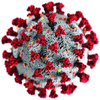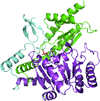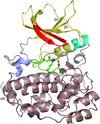issue contents
April 2020 issue

Cover illustration: Crystal structure of monomeric Amuc_1100 from Akkermansia muciniphila [Mou et al. (2020), Acta Cryst. F76, 168-174]. Many human diseases, such as obesity and diabetes, often involve intestinal microbes. One such probiotic bacterium, Akkermansia muciniphila, has been shown to improve glucose homeostasis and to contribute to gut health. Amuc_1100, an outer membrane in A. muciniphila, may play an important role in the interplay between the microbe and the host.
editorial
 access
accessresearch communications
 access
accessaddenda and errata
 access
access

 journal menu
journal menu

















![[publBio]](/logos/publbio.gif)





